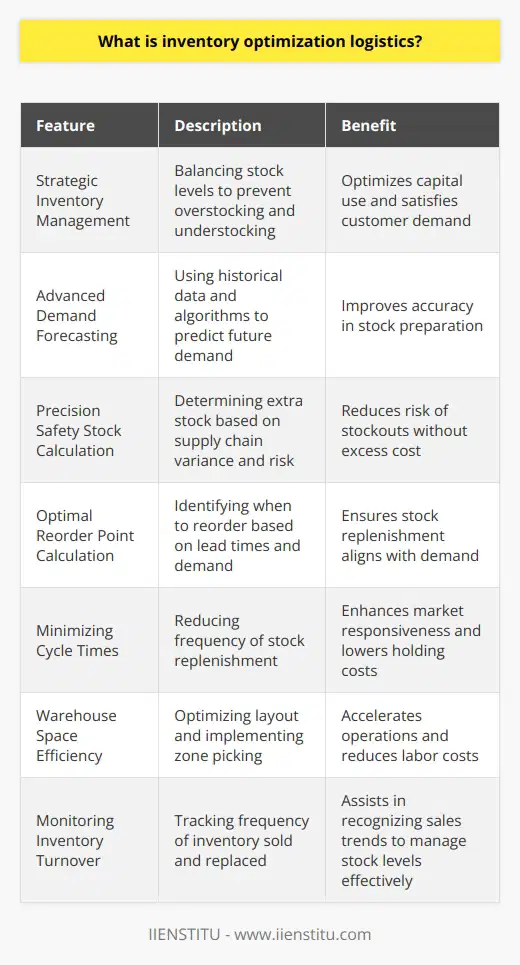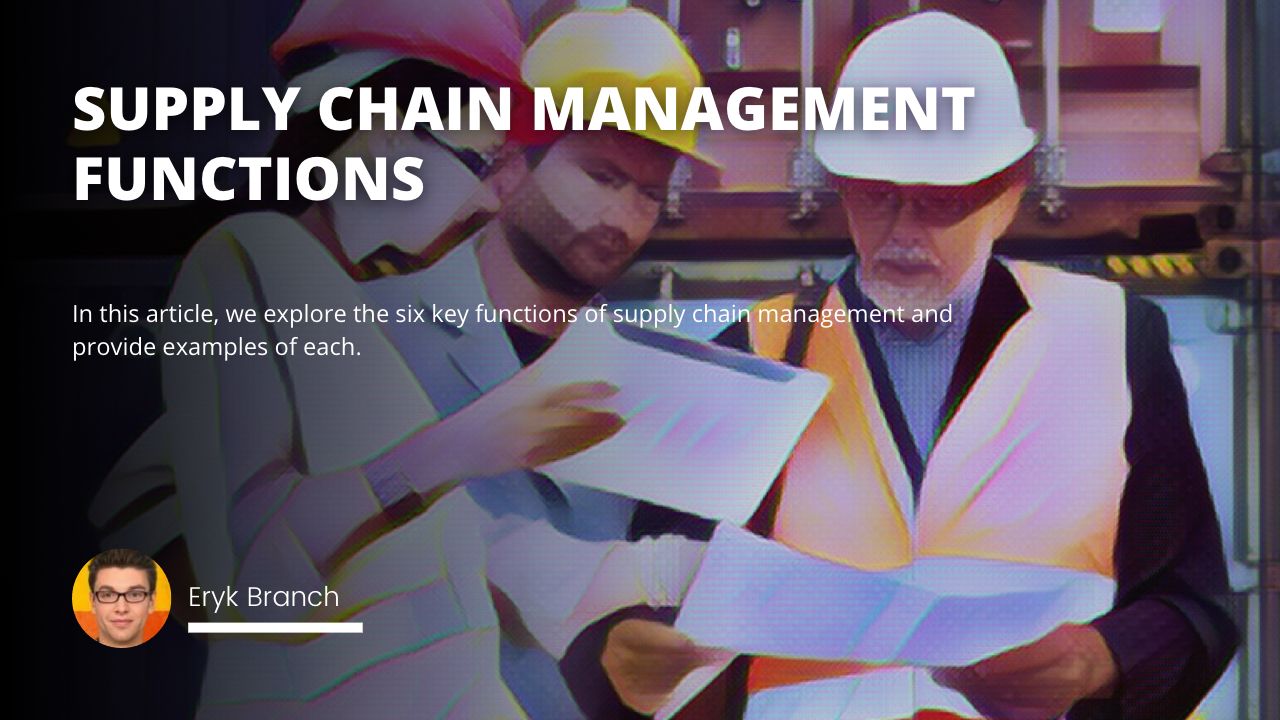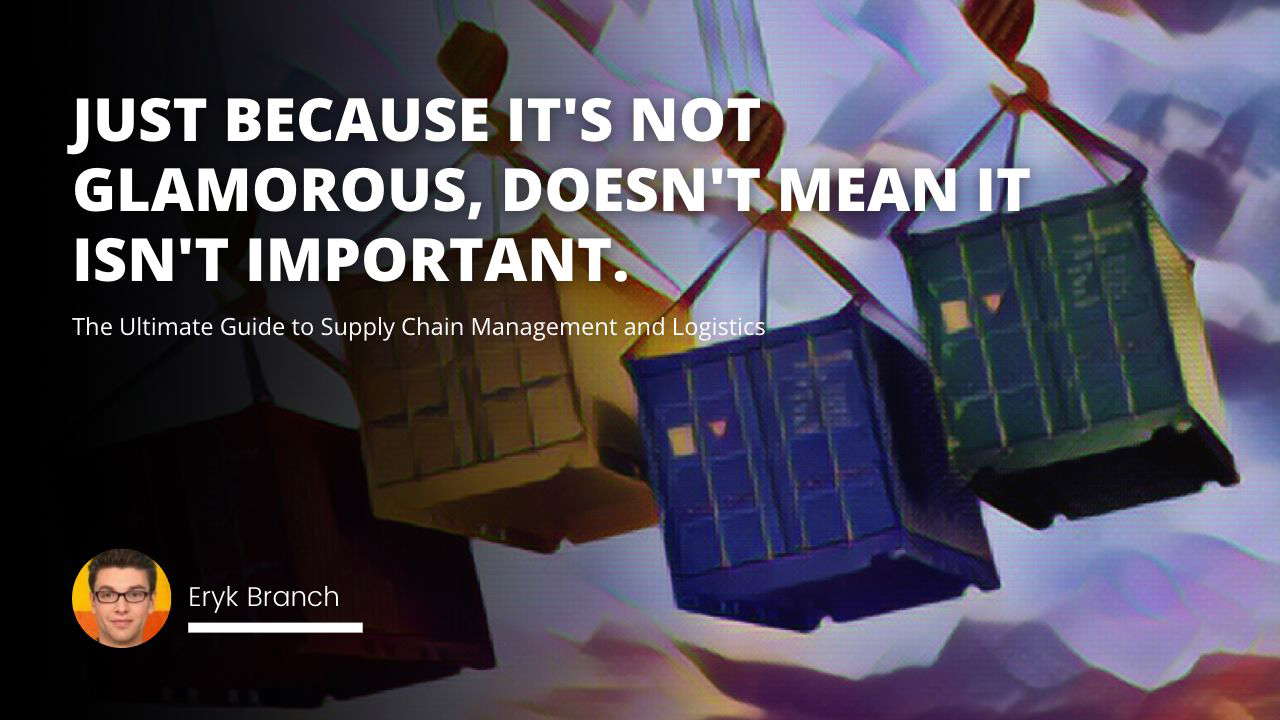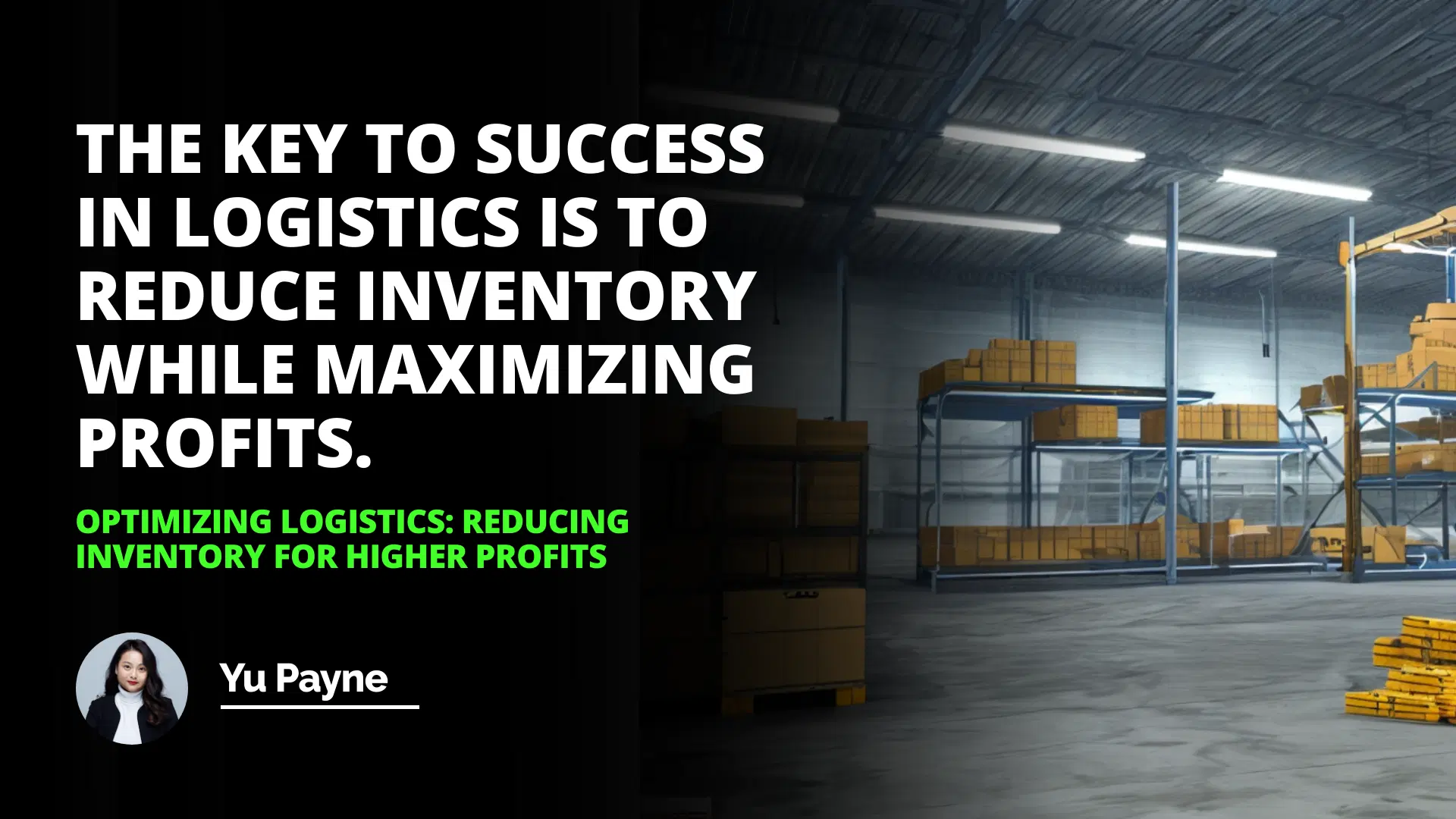
Inventory reduction is an essential part of a successful business strategy. It involves reducing the amount of inventory purchased, stored, and held by a company to reduce costs while still meeting customer service goals. Traditional inventory management techniques focus on ensuring the right amount of inventory is held in the right place at the right time.
Companies can optimize logistics and reduce inventory by implementing just-in-time inventory management and cross-docking strategies, reducing the amount of inventory and the time that inventory is held. By reducing inventory, companies can reduce costs associated with the inventory and maximize profits.
Introduction
Inventory Reduction: An Overview
Traditional Inventory Management
Optimizing Logistics: Reducing Inventory
Conclusion
Introduction: Inventory reduction is a critical component of a successful business strategy. Inventory is an asset and can represent a significant cost for a business. As such, it is essential to ensure that the inventory is managed efficiently to ensure that the company can maximize profits. This article will provide an overview of inventory reduction and discuss the traditional inventory management techniques and strategies for optimizing logistics and reducing inventory.
Most Searched Long Tail Keyword: Asset Tracking Benefits İn Business Operations
How To Manage Risk Within The Supply Chain İnterview Question Strategies
Inventory Reduction: An Overview
Inventory reduction is reducing the amount of inventory held by a company. This can be done by reducing the amount of inventory purchased, the amount of inventory stored, and the amount of time that inventory is held. The goal of inventory reduction is to reduce costs associated with the inventory while still meeting customer service goals.
Traditional Inventory Management
Traditionally, inventory management has focused on ensuring that the right amount of inventory is held correctly at the right time. This is done by ensuring that the right amount of inventory is purchased and stored in the right place and for the right amount of time. This is done to ensure that customer service goals are met.
Optimizing Logistics: Reducing Inventory
In order to optimize logistics and reduce inventory, companies must focus on two main areas: reducing inventory and reducing the time that inventory is held. Companies can reduce inventory by reducing the amount purchased and stored and the time that inventory is held. This can be done by implementing just-in-time inventory management and cross-docking strategies.
Just-in-time inventory management is a strategy that focuses on reducing the amount of inventory a company holds. This is done by ensuring that inventory is purchased and delivered just in time for when it is needed. This reduces the amount of inventory held by the company and the amount of time that inventory is held.
Cross-docking is another strategy that can be used to reduce inventory. Cross-docking is transferring products from one mode of transportation to another without storing them. This reduces the time that inventory is held and the amount of inventory that is held by the company.
Conclusion: Inventory reduction is essential to a successful business strategy. By reducing the amount of inventory held, companies can reduce costs associated with the inventory while still meeting customer service goals. Traditional inventory management focuses on ensuring that the right amount of inventory is held correctly at the right time.
However, companies can optimize logistics and reduce inventory by implementing just-in-time inventory management and cross-docking strategies. By reducing the amount of inventory and the time that inventory is held, companies can reduce costs associated with the inventory while still meeting customer service goals.
The key to success in logistics is to reduce inventory while maximizing profits.
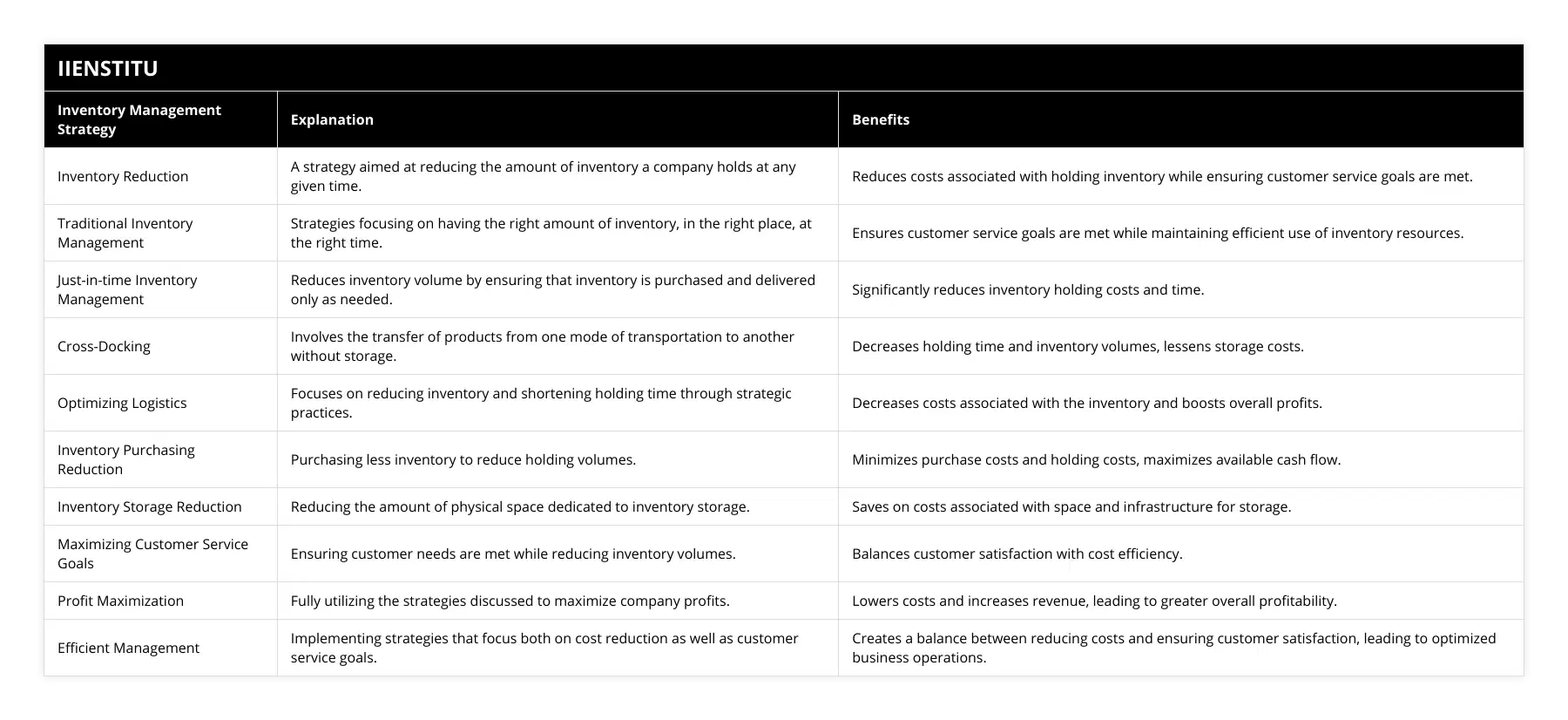
Frequently Asked Questions
What strategies can be employed to reduce inventory and optimize logistics for higher profits?
In today's competitive business environment, inventory and logistics optimization are essential for companies to stay competitive and maximize profits. With the increasing cost of raw materials, transportation, and storage, optimizing inventory and logistics has become increasingly crucial for businesses to remain profitable. In this article, we will discuss several strategies that can be employed to reduce inventory and optimize logistics for higher profits.
One of the most effective strategies for reducing inventory is implementing a just-in-time (JIT) production system. With this system, companies can produce only what is necessary and when necessary, thus avoiding storing large quantities of raw materials and finished products. Implementing a JIT system requires careful coordination of production and supply chains, but it can result in significant cost savings.
Another strategy for inventory optimization is to make use of existing inventory data. Companies should take advantage of existing inventory data to identify areas for improvement and determine where inventory can be minimized. For example, companies can use data to identify items with high demand or rarely used items and adjust inventory levels accordingly. This data-driven approach can help companies reduce waste and unnecessary costs.
Finally, companies should consider using advanced technologies to optimize their logistics operations. Technologies such as artificial intelligence (AI) and machine learning can automate and optimize the delivery of goods and reduce costs associated with transportation and storage. Additionally, these technologies can help companies better track orders and shipments, ensuring that goods arrive on time and reducing the risk of lost or damaged shipments.
In conclusion, companies can employ various strategies to reduce inventory and optimize logistics for higher profits. Implementing a JIT production system, taking advantage of existing inventory data, and utilizing advanced technologies can help companies reduce costs and improve efficiency. By implementing these strategies, companies can remain competitive and maximize profits in today's challenging business environment.

How does traditional inventory management differ from optimizing logistics for reducing inventory?
Inventory management manages the materials, goods, and services a business needs to purchase and sell to operate effectively. Traditional inventory management focuses on the physical storage and tracking of the inventory and its associated costs, such as labor and transportation. Optimizing logistics for reducing inventory, however, takes a more holistic approach to inventory management that includes evaluating the entire supply chain process.
Traditional inventory management is focused on inventory optimization and cost control. It involves the tracking of inventory levels, the forecasting of future demand, the calculation of inventory costs, and the determination of order quantities and delivery schedules. Maintaining sufficient inventory levels to meet customer demands and avoid stock-outs is essential. However, it is also essential to minimize inventory costs, such as storage and carrying costs, by reducing inventory levels as much as possible.
In contrast, optimizing logistics for reducing inventory goes beyond traditional inventory management by considering the entire supply chain process. This includes evaluating the inventory needs of each customer, the production process, the transportation process, and the customer service process. By evaluating the entire supply chain process, a business can identify and target areas where inventory can be reduced, such as reducing lead times, streamlining production, and improving customer service.
In addition, optimizing logistics for reducing inventory also involves using technology and analytics to identify areas of potential improvement in the supply chain. For example, predictive analytics can forecast customer demand and optimize inventory levels. Similarly, analytical models can be used to identify inefficiency in the supply chain, such as delays in production or transportation, and develop strategies to reduce inventory costs.
In conclusion, optimizing logistics for reducing inventory is a more holistic approach than traditional inventory management. It involves using technology and analytics to identify areas of potential improvement in the supply chain and to develop strategies to reduce inventory levels and costs. Businesses can optimize their inventory levels and reduce overall inventory costs by taking a more comprehensive approach to inventory management.

What are the potential benefits of reducing inventory through optimizing logistics?
Every business strives to reduce inventory and ensure efficient logistics operations. By optimizing logistics, businesses can reduce unnecessary inventory, eliminate waste, and significantly reduce costs. This article will discuss some of the potential benefits that can be achieved from reducing inventory by optimizing logistics.
First, reducing inventory can help to reduce holding costs. Most businesses must keep a certain inventory level to meet customer demand. However, if inventory levels are too high, it can lead to losses due to wastage and obsolescence of goods. Businesses can minimize holding costs such as warehousing, storage, and transportation by optimizing logistics and reducing inventory. In addition, optimizing logistics can help to lower the risk of stockouts, which can lead to a loss of customer satisfaction and sales.
Second, reducing inventory through optimizing logistics can help to improve customer service. By optimizing logistics, businesses can reduce lead times and promptly deliver goods to customers. This can help to improve customer service and ensure that customers receive their orders quickly and efficiently. In addition, optimizing logistics can help to reduce the risk of stockouts, which can lead to a loss of customer satisfaction and sales.
Third, reducing inventory through optimizing logistics can help to increase efficiency. Optimizing logistics can help streamline the supply chain, leading to improved productivity and reduced costs. By minimizing inventory levels, businesses can reduce the time and resources needed to manage and maintain inventory, leading to improved efficiency.
Finally, reducing inventory through optimizing logistics can help to improve cash flow. By reducing inventory levels, businesses can reduce their working capital requirements, which can help to improve cash flow. In addition, optimizing logistics can help to reduce transportation costs, which can also help to improve cash flow.
In conclusion, reducing inventory through optimizing logistics can provide many potential benefits, such as reducing holding costs, improving customer service, increasing efficiency, and improving cash flow. By optimizing logistics, businesses can reduce inventory levels and costs while ensuring that customer demand is met.
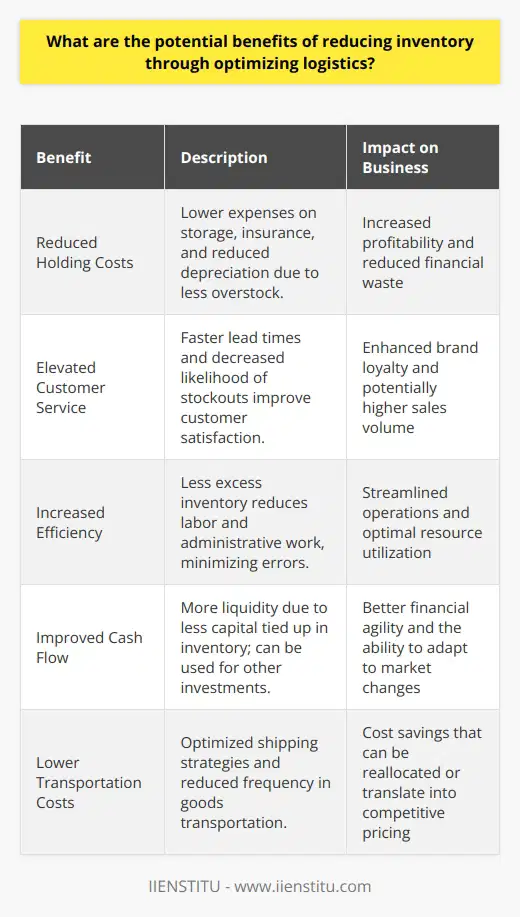
Does reducing inventory increase profit?
Inventory Reduction and Profitability
An essential determinant of profitability is the optimization of inventory management. Reducing inventory has a direct impact on increasing profit, especially when executed strategically. By reducing excessive stock, retailers can streamline their operations for maximum efficiency.
Lowering Holding Costs
A significant advantage of reduced inventory is the corresponding decrease in holding costs. These costs include storage, insurance, and potential obsolescence, all of which add to overall expenses. When companies have less inventory on hand, these costs decrease, resulting in higher profit margins.
Improved Cash Flow
Another benefit of reducing inventory levels is the improvement in cash flow. When businesses invest less in inventory, they free up capital for other investments or operational needs. This increased cash flow allows companies to reinvest in growth opportunities, further enhancing profitability.
Reduced Risk of Stock Obsolescence
As product lifecycles become shorter, the risk of inventory becoming obsolete, damaged, or spoiling increases. By reducing inventory, companies lower the risk of holding unsellable or undervalued items. Ultimately, this proactive approach minimizes the potential for significant financial losses and supports higher profits.
Increased Sales Efficiency
Reducing inventory can also lead to better inventory management, resulting in more efficient sales. Optimized stock levels enable retailers to focus on fast-selling items, minimizing stockouts, and improving overall customer satisfaction. Accurate inventory tracking and forecasting allow businesses to meet demand without overstocking, contributing to increased profitability.
In conclusion, strategically reducing inventory contributes to increased profit in several ways. Lower holding costs, improved cash flow, reduced risk of stock obsolescence, and increased sales efficiency all contribute to the positive financial outcomes of inventory reduction. By optimizing their inventory management, businesses can streamline operations and enhance overall profitability.
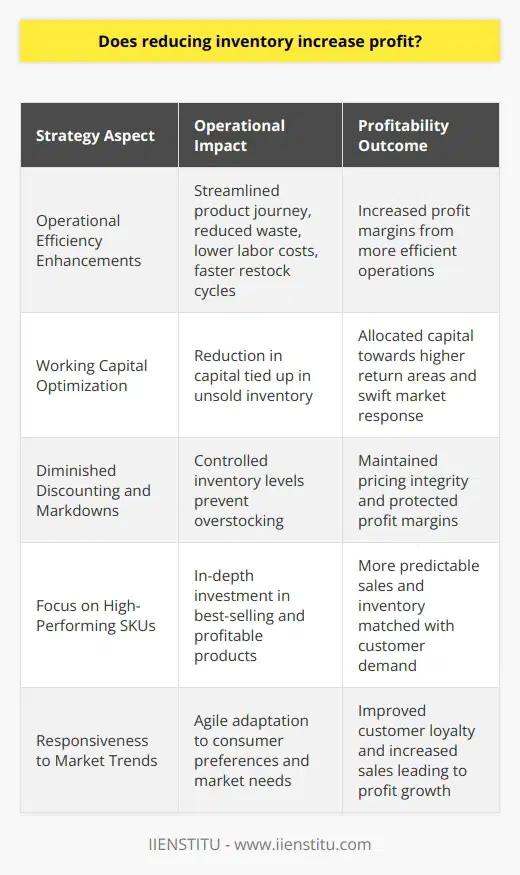
How can inventory costs be reduced in logistics?
**Efficient Inventory Management System**
Inventory costs can be reduced in logistics through the implementation of an efficient inventory management system. This process involves accurately tracking the stock levels and understanding the demand patterns of the products. It allows businesses to determine the right amount of inventory to hold at any given time to meet customer requirements and minimize holding costs.
**Use of Technological Tools**
One approach to improve the inventory management system is the adoption of technological tools, such as warehouse management systems (WMS) and barcode scanners. WMS enable businesses to automate several aspects of the inventory management process and provide real-time data on inventory levels, helping in the maintenance of optimal stock levels. Barcode scanners aid in the speedy and error-free recording of inventory movements, which further enhances the reliability of the inventory data.
**Just-in-Time Inventory Management**
Another tactic for reducing inventory costs is the just-in-time (JIT) inventory management technique. JIT is an approach in which businesses order inventory only when they anticipate a demand for a product, thereby minimizing the need for extensive warehousing and storage. This technique can lead to reduced holding costs and an overall decrease in the risk of inventory obsolescence.
**Effective Supplier Management**
Forging strong relationships with suppliers is essential in reducing inventory costs. This involves negotiating better terms and delivery schedules, which can have a significant impact on the total logistics costs. By collaborating with reliable suppliers, businesses can better manage their inventory levels and ensure a timely and consistent supply of products, reducing safety stock and carrying costs.
**Regular Performance Evaluation**
Regularly evaluating the performance of the inventory management system is also vital in reducing costs. By analyzing the key performance indicators (KPIs), such as order accuracy, fill rates, and stock rotation, businesses can identify the areas needing improvement and make the necessary adjustments. Continually optimizing the inventory management process will help minimize costs and enhance customer satisfaction.
In conclusion, to reduce inventory costs in logistics, businesses should implement an efficient inventory management system, adopt technological tools, employ JIT inventory management techniques, manage suppliers effectively, and regularly evaluate their systems' performance. By adopting these strategies, businesses can optimize their inventory levels, minimize carrying costs, and ultimately increase profitability.
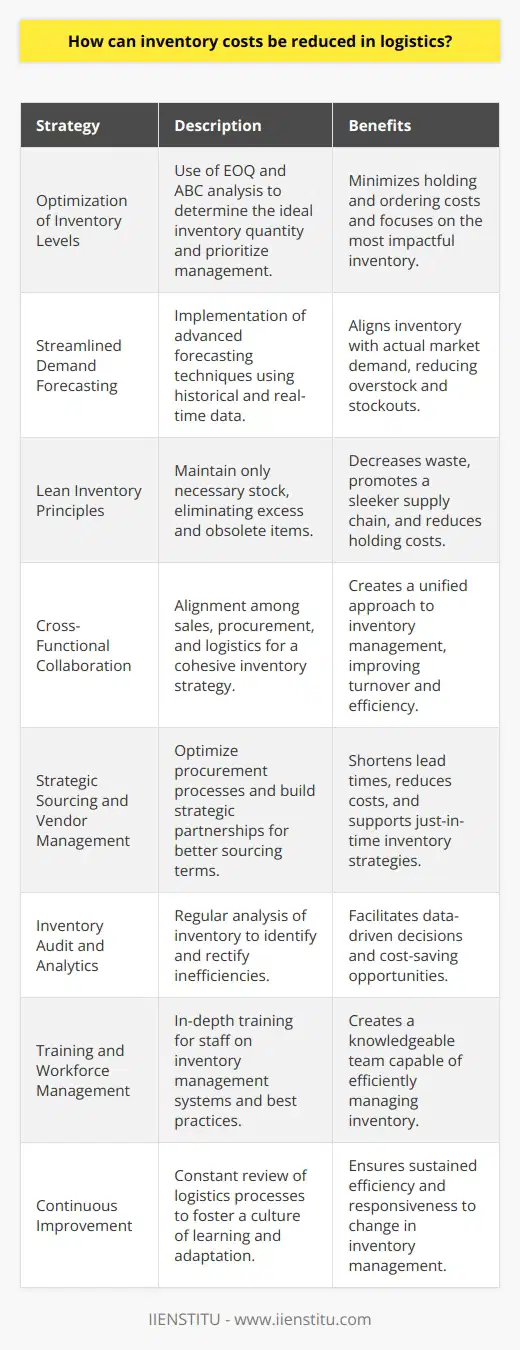
What is inventory optimization logistics?
Inventory Optimization Logistics: Definition and Importance
Inventory optimization logistics refers to the strategic management of product inventory to reduce costs and improve customer satisfaction. This entails accurately predicting demand, controlling stock levels, and efficiently utilizing warehouse space to ensure timely product availability. It is a crucial component of supply chain management that focuses on balancing the trade-offs between carrying excessive inventory and risking stockouts, ultimately leading to enhanced operational effectiveness.
Demand Forecasting and Safety Stock
A key aspect of inventory optimization logistics involves demand forecasting, which is the process of predicting future sales based on historical trends, market research, and statistical analysis. Accurate demand forecasts enable companies to maintain appropriate inventory levels, thereby reducing holding and stockout costs. Additionally, inventory managers must calculate the right amount of safety stock, which serves as a buffer against uncertainties in demand and lead times. An optimal safety stock level minimizes the risk of stockouts while preventing overstocking and the resulting carrying costs.
Reorder Point and Cycle Time
Another essential component of inventory optimization logistics is determining the reorder point, which is the inventory level at which new stock should be ordered to replenish supplies before they run out. The reorder point considers factors such as lead time, demand variability, and desired service level, ensuring that orders are placed on time and in the correct quantities. Furthermore, inventory managers can optimize cycle times, which relate to the frequency and duration of order replenishment. By minimizing cycle time, companies can respond more quickly to shifts in demand and reduce inventory holding periods.
Warehouse Space Utilization
Effectively managing warehouse space is vital to optimizing inventory logistics. Optimizing warehouse layout enables companies to better utilize available space, easing product retrieval processes and reducing labor costs. Additionally, strategic placement of fast-moving items near dispatch areas can further streamline operations and save time. Implementing automated storage and retrieval systems (AS/RS) and embracing digital inventory management tools can further enhance warehouse space utilization.
Inventory Turnover Ratio
A useful metric for gauging inventory optimization is the inventory turnover ratio, which measures how many times a company sells and replaces its inventory during a given period. A higher turnover ratio indicates that products are being sold quickly, and the company is efficiently managing its stock levels. Businesses can use the inventory turnover ratio to identify slow-moving items and evaluate the effectiveness of their inventory management strategies.
In conclusion, inventory optimization logistics plays a crucial role in streamlining supply chain operations and improving overall business performance. By accurately forecasting demand, maintaining optimal safety stock levels, determining reorder points, minimizing cycle times, and effectively utilizing warehouse space, companies can significantly reduce inventory-related costs and increase customer satisfaction.
